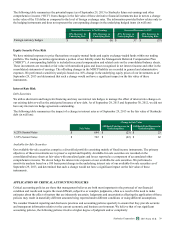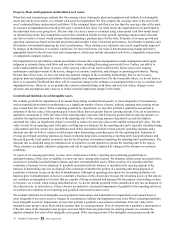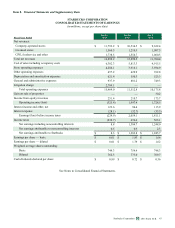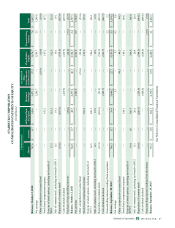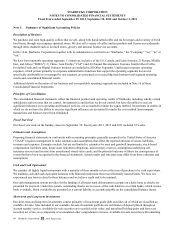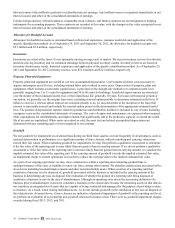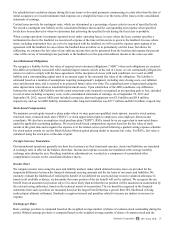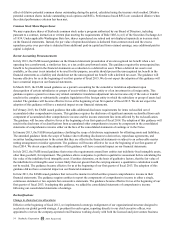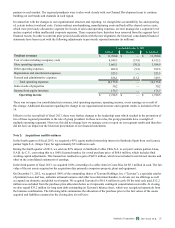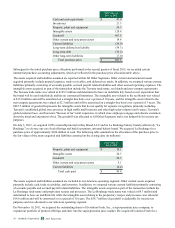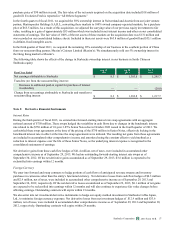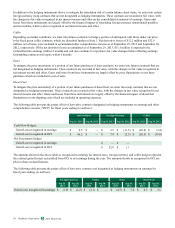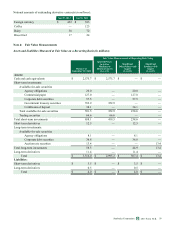Starbucks 2013 Annual Report Download - page 57
Download and view the complete annual report
Please find page 57 of the 2013 Starbucks annual report below. You can navigate through the pages in the report by either clicking on the pages listed below, or by using the keyword search tool below to find specific information within the annual report.
49
maturities of less than one year and those identified by management at the time of purchase to be used to fund operations
within one year are classified as short term. All other available-for-sale securities, including all of our auction rate securities,
are classified as long term. Unrealized losses are charged against net earnings when a decline in fair value is determined to be
other than temporary. We review several factors to determine whether a loss is other than temporary, such as the length and
extent of the fair value decline, the financial condition and near term prospects of the issuer, and whether we have the intent to
sell or will likely be required to sell before the securities anticipated recovery, which may be at maturity. Realized gains and
losses are accounted for using the specific identification method. Purchases and sales are recorded on a trade date basis.
We also have a trading securities portfolio, which is comprised of marketable equity mutual funds and equity exchange-traded
funds. Trading securities are recorded at fair value with unrealized holding gains and losses included in net earnings.
Fair Value
Fair value is the price we would receive to sell an asset or pay to transfer a liability (exit price) in an orderly transaction
between market participants. We determine fair value based on the following:
Level 1: The carrying value of cash and cash equivalents approximates fair value because of the short-term nature of these
instruments. For government treasury securities, we use quoted prices in active markets for identical assets to determine fair
value.
Level 2: For corporate and agency bonds, for which a quoted market price is not available for identical assets, we determine fair
value based upon the quoted market price of similar assets or the present value of expected future cash flows, calculated by
applying revenue multiples to estimate future operating results and using discount rates appropriate for the duration and the
risks involved. Fair values for commercial paper are estimated using a discounted cash flow calculation that applies current
imputed interest rates of similar securities. Fair values for certificates of deposit are estimated using a discounted cash flow
calculation that applies current interest rates to aggregate expected maturities. The fair value of our long-term debt is estimated
based on the quoted market prices for the same or similar issues or on the current rates offered to us for debt of the same
remaining maturities.
Level 3: We determine fair value of our auction rate securities using an internally developed valuation model, using inputs that
include interest rate curves, credit and liquidity spreads, and effective maturity.
Derivative Instruments
We manage our exposure to various risks within the consolidated financial statements according to a market price risk
management policy. Under this policy, we may engage in transactions involving various derivative instruments to hedge
interest rates, commodity prices and foreign currency denominated revenues, purchases, assets and liabilities. We generally do
not offset derivative assets and liabilities in our consolidated balance sheets or enter into derivative instruments with maturities
longer than five years.
We enter into fixed-price and price-to-be-fixed green coffee purchase commitments. Price-to-be-fixed contracts are purchase
commitments whereby the quality, quantity, delivery period, and other negotiated terms are agreed upon, but the date, and
therefore price, at which the base “C” coffee commodity price component will be fixed has not yet been established. For these
types of contracts, either Starbucks or the seller has the option to “fix” the base “C” coffee commodity price prior to the
delivery date. For both fixed-price and price-to-be-fixed purchase commitments, we expect to take delivery of and to utilize the
coffee in a reasonable period of time and in the conduct of normal business. Accordingly, these purchase commitments qualify
as normal purchases and are not recorded at fair value on our balance sheets.
We record all derivatives on the balance sheets at fair value. For a cash flow hedge, the effective portion of the derivative's gain
or loss is initially reported as a component of other comprehensive income (“OCI”) and subsequently reclassified into net
earnings when the hedged exposure affects net earnings. For a net investment hedge, the effective portion of the derivative's
gain or loss is reported as a component of OCI.
Cash flow hedges related to anticipated transactions are designated and documented at the inception of each hedge by matching
the terms of the contract to the underlying transaction. We classify the cash flows from hedging transactions in the same
categories as the cash flows from the respective hedged items. Once established, cash flow hedges are generally not removed
until maturity unless an anticipated transaction is no longer likely to occur. For discontinued or dedesignated cash flow hedges,
the related accumulated derivative gains or losses are recognized in net interest income and other on the consolidated
statements of earnings.
Forward contract effectiveness for cash flow hedges is calculated by comparing the fair value of the contract to the change in
value of the anticipated transaction using forward rates on a monthly basis. For net investment hedges, the spot-to-spot method
is used to calculate effectiveness. Under this method, the change in fair value of the forward contract attributable to the changes
in spot exchange rates (the effective portion) is reported as a component of OCI. The remaining change in fair value of the
2013 10-K
Starbucks Corporation Form


